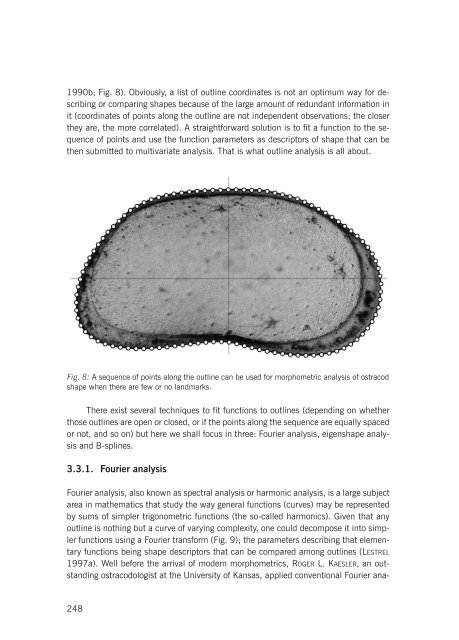Geo11_89_Baltanas_Danielopol_Geometric_Morphometrics
Geo11_89_Baltanas_Danielopol_Geometric_Morphometrics
Geo11_89_Baltanas_Danielopol_Geometric_Morphometrics
Create successful ePaper yourself
Turn your PDF publications into a flip-book with our unique Google optimized e-Paper software.
1990b; Fig. 8). Obviously, a list of outline coordinates is not an optimum way for describing<br />
or comparing shapes because of the large amount of redundant information in<br />
it (coordinates of points along the outline are not independent observations; the closer<br />
they are, the more correlated). A straightforward solution is to fit a function to the sequence<br />
of points and use the function parameters as descriptors of shape that can be<br />
then submitted to multivariate analysis. That is what outline analysis is all about.<br />
Fig. 8: A sequence of points along the outline can be used for morphometric analysis of ostracod<br />
shape when there are few or no landmarks.<br />
There exist several techniques to fit functions to outlines (depending on whether<br />
those outlines are open or closed, or if the points along the sequence are equally spaced<br />
or not, and so on) but here we shall focus in three: Fourier analysis, eigenshape analysis<br />
and B-splines.<br />
3.3.1. Fourier analysis<br />
Fourier analysis, also known as spectral analysis or harmonic analysis, is a large subject<br />
area in mathematics that study the way general functions (curves) may be represented<br />
by sums of simpler trigonometric functions (the so-called harmonics). Given that any<br />
outline is nothing but a curve of varying complexity, one could decompose it into simpler<br />
functions using a Fourier transform (Fig. 9); the parameters describing that elementary<br />
functions being shape descriptors that can be compared among outlines (LESTREL<br />
1997a). Well before the arrival of modern morphometrics, ROGER L. KAESLER, an outstanding<br />
ostracodologist at the University of Kansas, applied conventional Fourier ana-<br />
248


